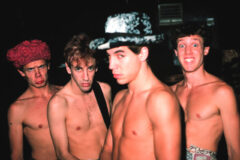Dusty Hill, who passed away on July 28, was born Joe Michael Hill in Dallas on May 19, 1949. He and his older brother Rocky were raised by their mother, Myrl, who moved the family to Memphis when Dusty was five. By night she was a nightclub singer and by day and she worked in a café that was frequented by a talented youngster named Elvis Presley.
As Dusty tells it, “When I was about seven, we moved back to Dallas. My mother brought one of Elvis’ 45s with her and put it in the jukebox where she worked as a waitress. So I started to get influenced by Elvis right away.
“I started singing professionally when I was about eight – in front of the jukebox and people would give me money.”
Soon after, Rocky learned to play guitar and Dusty picked up the bass when he was 13. He explained, “Rocky played guitar and I sang. Then, later, we met this guy who played drums so now we have a guitarist, a singer and a drummer. Naturally Rocky said, ‘You should play bass.’” Dusty had played cello in school so the idea wasn’t really that far-fetched. “I came home from school and there was a bass guitar and little amplifier.”

Also Read
THE EYE OF JIMMY STEINFELDT
Rocky and Dusty were part of various bands: The Warlocks, The Cellar Dwellers, morphing into The American Blues with drummer Frank Beard. They did their best to live up to their name by dying their hair blue. The band stayed together a few years and literally left a “blueprint” on many a pillowcase in quite a few “economy” hotels around the state of Texas. The brothers later joined forces with blues great Freddie King who would later be inducted into the Rock and Roll Hall of Fame by Dusty and his ZZ Top mates. They played the famed Fillmore in San Francisco together. Returning home and after a stint as a day laborer, Dusty found himself in Houston in late 1969 where he famously backed up Lightnin’ Hopkins at The Old Quarter, a folk music club.
Frank, his former bandmate, mentioned that guitarist Billy Gibbons, late of the Moving Sidewalks, was looking for a bass player; Frank suggest that Dusty try out. The afternoon audition at The Catacombs, an empty nightclub, devolved into a jam session where the three played a blues shuffle in the key of C for — as Billy remembers it — about three hours. The 50-plus year lineup of ZZ Top was born that day and the three played their first gig together on February 10, 1970 at the Knights of Columbus Hall in Beaumont.
The rest, as is often said, is history but worth recounting. Manager Bill Ham arranged for the new band to be signed to London Records and their first album, cleverly titled ZZ Top’s First Album, was released the next year. This was followed by 1972’s Rio Grande Mud, promoted with ceaseless touring; one time playing to an audience of a single paying customer. 1973’s Tres Hombres changed everything. It was their first Gold-certified album and included “La Grange,” which almost broke into the Top 40, tragically stalling out at #41. Then came Fandango! that not only went Gold but also included “Tush,” the band’s first Top 20 single that, it should be noted, featured Dusty on lead vocal.
A lengthy hiatus ensued and Dusty got a day job while the band was off the road. He told an interviewer a few years ago, “I had a short beard, regular length, and if you take off the hat and shades and wear work clothes and put ‘Joe’ on my work shirt, people are not expecting to see you. A couple of people did ask me, and I just lied, and I said: ‘No! Do you think I’d be sitting here?’”
ZZ Top signed to Warner Bros. where Degüello, released in 1979, achieved platinum status. Then came El Loco, followed by Eliminator, which catapulted ZZ Top into rock’s stratosphere thanks, in part, to three smash hit singles – “Gimme All Your Lovin’,” “Sharp Dressed Man” and “Legs.” All of these were the subject of iconic music videos that turned Dusty, thanks to constant MTV play, into something of a TV star. The idea was to have the band, in essence, serve as bystanders in their own videos rather than as protagonists. It served them well with the album going on to sell over 10 million copies in the United States and millions more overseas. With all the band’s newfound notoriety, his and Billy Gibbons’ beards became memes before the term had even been coined. At the time the Washington Post reported: “Mr. Hill said there was no question of ever shaving, even if he were to retire. ‘I’m a sex symbol,” he said. ‘Is that wild? It blows me away. I mean, I’ve always known it, I just figured nobody else did.’”
ZZ Top album releases continued with Dusty and the band becoming part of American iconography. New Yorker cartoons, being recognized as Official Heroes of the State of Texas and induction into the Rock and Roll Hall of Fame – by Keith Richards of the Rolling Stones – highlight the kind of universal recognition the band was accorded. They were seen in the film Back To The Future, Part III playing a musical trio in the old west. “Hank Gets Dusted,” an episode of the long-running series King of The Hill starred an animated Dusty who was cast as Hank Hill’s prankster cousin. Roles in Deadwood, The Drew Carey Show, Two and a Half Men, among others, cemented their place in popular culture. More recently, the band was the subject of a Grammy-nominated feature-length documentary titled That Little Ol’ Band From Texas that benefited from Dusty’s sanguine commentary and insights.

I knew Dusty for more than 40 of ZZ Top’s 52 years, as the group’s publicist, sometime confidant and friend. I was always impressed with his absolute lack of pretense and open nature. He once told me that the period after Thanksgiving and into Christmas was his favorite time of the year, because he was able to circulate freely with the general public in malls and stores, as he just looked like another Santa Claus among us.
When ZZ Top was filming its legendary “Sharp Dressed Man” video in downtown LA with a bank building as a stand in for a tony nightclub, he and his bandmates were on the periphery of the action as they and filmmaker Tim Newman (Randy’s cousin) thought that the band should never be the protagonists in their own videos but rather, bystanders to the action, akin to a Greek chorus. Dusty found himself on the other side of a police barricade for a cigarette break while the filming was proceeding. He was accosted by a homeless man who suggested that some of the lighting choices that the director had made should, perhaps, be reconsidered. Dusty listened attentively and courteously to the bedraggled expert and told him he’d take his suggestions under advisement. He said to me, “Hey, this is Hollywood, maybe he knows something…”
Dusty treasured his visits to New York which enjoyed not as a rock star from as a “golly-gee” kind of tourist. He made it a point to take in a Broadway show when in town – I specifically remember his catching “Movin’ Out,” the Billy Joel – Twyla Tharpe musical one time. Dusty was never “too hip for the room” and therein lay part of his charm. He was happy to be in show business and was, himself, an accomplished showman – I mean, those fuzzy guitars! – but he could appreciate the process as a “civilian.”
In his extraordinary life, Dusty Hill would go from performing as a child in front of a jukebox to the heights of success in music. The American dream came true for The Dust.




